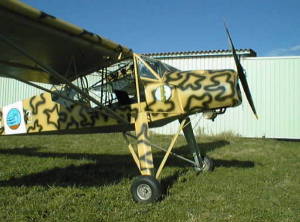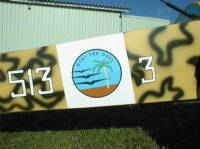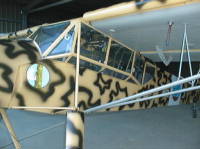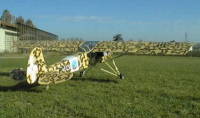
| AVIAZIONE LEGGERA ON LINE - IL GRANDE SITO DELL'AVIAZIONE SPORTIVA ITALIANA |
|---|

|
 The Slepcev Storch is a 3/4 scale replica of the famous Fiesler Storch, a German built reconnaissance aircraft used during Second World War.
The Slepcev Storch is a 3/4 scale replica of the famous Fiesler Storch, a German built reconnaissance aircraft used during Second World War.
Nestor Slepcev, a Slav long settled in Australia, began producing this ultralight aircraft a few years ago, gaining immediate success amongst many airplane lovers. This was mainly due to the Storch's STOL characteristics and, quite certainly, also because of the innate attractiveness that replicas have.
And Italy is where Slepcev has found the most receptive market, having sold in this Country over half of all the kits sold in the world.
The Storch I have had the chance to test fly has been built from the original kit imported from Australia a couple of years ago. Following a troublesome initial period with engines which proved to be unreliable, the aircraft has been equipped with the classic Rotax 912.
There is a really neat story behind the colour scheme chosen by its owner, Federico Vallauri.
The Regia Aeronautica (Italian Airforce during WWII) bought about thirty "storches" from Germany. Almost all of them were to be used for internal purposes and were painted with the metropolitan colour scheme, olive green, except for one which was sent to the African front and was painted with a desert colour scheme with the typical smoke rings on an ochre base colour.
 It is this particular plane which inspired the paint job on the ultralight being described here. Flying on it is a little bit like reliving our past history. Needless to say, the ultralight Storch is equipped with a gunner seat complete with machine gun!
It is this particular plane which inspired the paint job on the ultralight being described here. Flying on it is a little bit like reliving our past history. Needless to say, the ultralight Storch is equipped with a gunner seat complete with machine gun!
The emblem of the 150th Gruppo Caccia (Fighter Squadron) painted on the sides has an interesting story behind it. It has also been chosen to remember the love for airplanes and the capabilities of those expert sailplane pilots who built it, first among them Giancarlo Maestri, who operate out of the Alzate Brianza airport, sort of "The Hangout" for airplane pilots.
What strikes you at first is the "real" airplane size of this ultralight, which has most likely contributed considerably to its success: 10 metre wingspan, almost 7 metres in length and 2.3 m in height!
I remember a Storch during a trip to the Oshkosh fly-in; I took refuge under its wings during a thunderstorm, and I must say that the original is really incredibly tall. Its gear legs, in particular, catch your eye: extremely long, they transfer loads directly to the upper part of the fuselage.
 Construction is of the classical type, steel fuselage with aluminum wings, all covered in cloth.
Construction is of the classical type, steel fuselage with aluminum wings, all covered in cloth.
The wings, supported by two steel struts each, have ailerons, flaps and the characteristic slat in the front, the latter being what gives the Storch excellent landing and STOL capabilities. The trim is operated through a bowden cable which acts on the slant of the stabilizer.
The prop, a wooden GT, has been carefully "aged" directly by the factory.
The aircraft can hold two passengers in tandem seating and can be flown "solo" from the front seat. A note of interest: on Italian aircraft, up to the end of WWII, one had to move the throttle lever backward to increase power. We find this is the same in this particular ultralight. Actually, this was by pure chance. In fact, the first engines that were installed had levers which worked in the opposite direction from that required by the Rotax. It's as if history wanted to leave its mark on this particular model.
Climbing abort is not that easy. The fuselage floor is at such height as to privilege the more athletic ones amongst us pilots; also, it forces one to put his feet directly on the wing struts, which is somewhat odd.
The cockpit is as roomy and comfortable as any "military" aircraft can be (not quite a Mercedes!). It is worth noticing that the fuselage has undergone some modifications in order to improve roominess, particularly in the rear seat area.
The seats cannot be adjusted, however, the plane has dual controls except for brakes and the flap lever. The rear pilot will have a hard time seeing the instruments installed in the front panel.
 After having started and warmed up the engine, we taxied to the holding point zigzagging just like in a typical taildragger.
After having started and warmed up the engine, we taxied to the holding point zigzagging just like in a typical taildragger.
Take-off, as expected, required 30 or 40 m of runway with flaps fully extended. We could have certainly done better but Federico, being a good military pilot, was not interested in showing off but rather in doing a safe flight.
And indeed, it was a very pleasant one; the roaring sound of the engine, adequately filtered by our headsets, was reassuring. The visibility is excellent and, being the reconnaissance plane that it is, its windows are angled such that you can even look directly below. Speed, quite obviously, is not a strongpoint of the Storch: about 100 km/h at 4800 rpm.
And you can't really call it a "clean" aircraft: there are corners, tubes and protuberances just about everywhere. On the other hand, the aircraft is very sensitive and every movement of the stick corresponds to an immediate change in the outside view!
I, being an absolutely normal pilot and with a surname which does not begin with Y (for Yeager!), could not manage to make it stall. After a few tries I gave up, I though I was going to rip the knob off the stick with all that pulling.

Flying the Storch is instinctive, except for the "backward" throttle. Landings are standard, although if you fly it too slow the elevator loses its efficacy. In any case, you can land the bird in about 40-50 m using the brakes.
The aircraft weighs 270 kg which, coupled with its slow stall speed, makes it a true ultralight (under Italian regulations).
For further information e-mail to Federico Vallauri: ico@ulm.it
Flavio Giacosa with the collaboration of Federico Vallauri
| Maximum speed | Km/h150 |
| VNE | 182 Km/h |
| Stall speed (flaps out) | 36 Km/h |
| Climb rate | 9,1 m/s (1800 ft/min) |
| Take-off distance | 39 mt |
| Landing distance | 34 mt |
| Ceiling | 5.000 mt (16.404 ft) |
| Engine | ROTAX 912 80 HP |
| Minimum fuel /td> | 20 lt |
| Maximum fuel | 60 lt. |
| Empty weight | 271 Kg |
| Maximum take-off weight | 450 Kg |
| Payload | 179 Kg |
| Height | 2,30 mt |
| Length | 6,95 mt |
| Wingspan | 10,00 mt |
| Wing loading at maximum weight | 28,125 Kg/mq |
| Seating | 2 in tandem |
| Main gear wheel size | 15" x 6" x 6" |
| Propeller: | diameter 183 cm.; pitch 113 cm. |
| Fuel consumption at 75% Power, corresponding to 94 Km/h | 13 lt/h |
| Manufacturer: | NESTOR SLEPCEV VRBAS, Beechwood NSW, 2446 Australia Tel./fax +61 65 85 6458 |